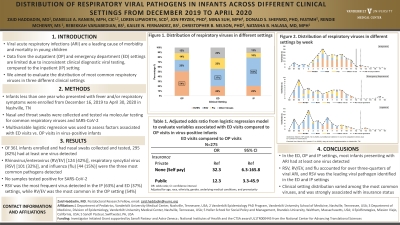Category: HAI: Surveillance
Poster Session: HAI: Surveillance
913 - Distribution of Respiratory Viral Pathogens in Infants Across Different Clinical Settings from December 2019 to April 2020


Zaid Haddadin
Postdoctoral Research Fellow
Vanderbilt University Medical Center; Division of Pediatric Infectious Diseases
Nashville, TennesseeDisclosure: CDC (Grant/Research Support, Research Grant or Support)Quidel Corporation (Grant/Research Support, Research Grant or Support)sanofi pasteur (Grant/Research Support, Research Grant or Support)

Danielle A. Rankin
Doctoral Candidate in Epidemiology
Vanderbilt University Medical Center
Nashville, TennesseeDisclosure: Sanofi Pasteur (Grant/Research Support, Research Grant or Support)
- ll
loren lipworth
Research Professor
Division of Epidemiology - 104370
Nashville, TennesseeDisclosure: I do not have any relevant financial / non-financial relationships with any proprietary interests.
- JF
Jon Fryzek
Principal Epidemiologist Practice Director
EpidStrategies, A Division of ToxStrategies, Inc.
Rockville, MDDisclosure: EpidStrategies (Employee)

Mina Suh
Senior Epidemiologist
Epidstrategies
Mission Viejo, CaliforniaDisclosure: EpidStrategies (Employee)

Donald S. Shepard
Professor
Brandeis University
Waltham, MassachusettsDisclosure: Sanofi Pasteur (Grant/Research Support)
- RM
Rendie McHenry
Research Asst III
Vanderbilt University Medical Center; Division of Pediatric Infectious Diseases
Nashville, TennesseeDisclosure: I do not have any relevant financial / non-financial relationships with any proprietary interests.
- RV
Rebekkah Varjabedian
Clin/Tran Research Coord II
Vanderbilt University Medical Center; Division of Pediatric Infectious Diseases
Nashville, TennesseeDisclosure: I do not have any relevant financial / non-financial relationships with any proprietary interests.

Kailee N. Fernandez
Clin/Tran Research Coordinator I
Vanderbilt University Medical Center; Division of Pediatric Infectious Diseases
Nashville, TennesseeDisclosure: I do not have any relevant financial / non-financial relationships with any proprietary interests.

Christopher B. Nelson
Associate Vice President
Sanofi
Swiftwater, PennsylvaniaDisclosure: I do not have any relevant financial / non-financial relationships with any proprietary interests.

Natasha B. Halasa
Craig Weaver Professor of Pediatrics
Vanderbilt University Medical Center
Nashville, TNDisclosure: Genentech (Other Financial or Material Support, I receive an honorarium for lectures - it's a education grant, supported by genetech)Karius (Consultant)Moderna (Consultant)Quidel (Grant/Research Support, Research Grant or Support)Sanofi (Grant/Research Support, Research Grant or Support)
Presenting Author(s)
Co-Author(s)
Background: Acute respiratory infections (ARI) are a major cause of morbidity and mortality in young children, with viral pathogens being the most common etiologies. However, due to limited and inconsistent clinical diagnostic viral testing in the outpatient (OP) setting compared to the inpatient (IP) setting, the actual burden and distribution of viral pathogens across these clinical settings remain largely underreported. We aimed to evaluate the frequency of common respiratory viruses in medically attended ARI in infants.
Methods:
We conducted a prospective viral surveillance study in Davidson County, TN. Eligible infants under one year presenting with fever and/or respiratory symptoms were enrolled from OP, emergency department (ED), or IP settings. Nasal swabs were collected and tested for common viral pathogens using Luminex® NxTAG Respiratory Pathogen Panel and for SARS-CoV-2 using Luminex® NxTAG CoV extended panel.
Results:
From 12/16/2019 to 4/30/2020, 364 infants were enrolled, and 361 (99%) had nasal swabs collected and tested. Of those, 295 (82%) had at least one virus detected; rhinovirus/enterovirus (RV/EV) [124 (42%)], respiratory syncytial virus (RSV) [101 (32%)], and influenza (flu) [44 (15%)] were the three most common pathogens detected. No samples tested positive for SARS-CoV-2. Overall, the mean age was 6.1 months, 50% were male, 45% White and 27% Hispanic. Figure 1 shows the total number of PCR viral testing results by month. RSV was the most frequent virus detected in the IP (63%) and ED (37%) settings, while RV/EV was the most common in the OP setting (Figure 2). Figure 3 displays viral seasonality by clinical setting, showing an abrupt decrease in virus-positive cases following the implementation of a stay-at-home order on March 23, 2020 in Nashville, TN. Distribution of PCR Testing Results in Each Month.png) Distribution of Respiratory Viruses in Different Settings
Distribution of Respiratory Viruses in Different Settings.png) Distribution of Respiratory Viruses in Different Settings by Season
Distribution of Respiratory Viruses in Different Settings by Season.png)
Conclusion:
Most medical encounters in infants are due to viral pathogens, with RSV, RV/EV, and flu being the most common. However, distributions differed by clinical setting, with RSV being the most frequently detected in the IP and ED settings, and second to RV/EV in the OP setting. Continued active viral ARI surveillance in various clinical settings is warranted. Preventative measures such as vaccines and infection control measures deserve study to reduce viral ARI burden.

